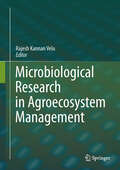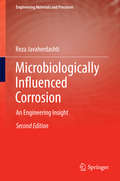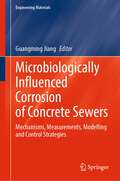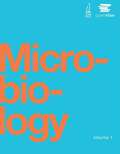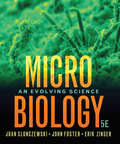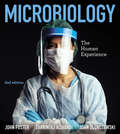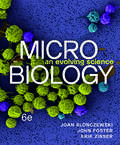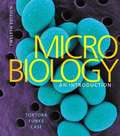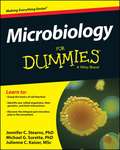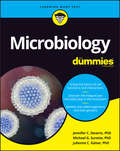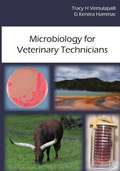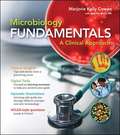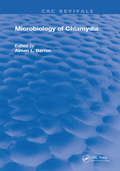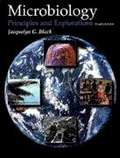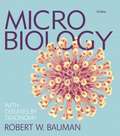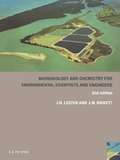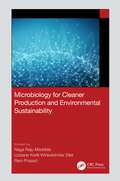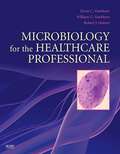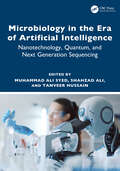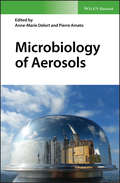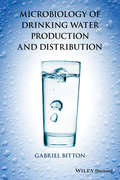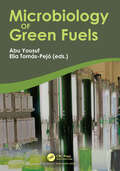- Table View
- List View
Microbiological Research In Agroecosystem Management
by Rajesh Kannan VeluAgroecosystem is an ideal dynamic functional system with a set of chemical and biological interaction taking place in plant surface either below or above the ground levels. These levels of interaction activities fundamentally with microorganism-plant-soil systems are extended upto the level of entire agricultural economy. Greatly simplified, the agroecosystems control the various range of energy flux, resources exchange, organic and inorganic nutrient budgets and population dynamics. The main aim of this edited volume is to provide a broad spectrum of agroecosystems structure, function and maintenance involved in microbial research. This book consists of 20 full length research articles focusing on the emerging problems in the field and the positive findings are identified on key areas of research such as biodiversity, ecosystem service, environmental cleaning in agroecology, etc. These articles are arranged progressively linking themselves thematically with photographs, figures and tables. Focused field articles are included which prove a valuable contribution to the field of agroecosystem management by microbial facilitations. The editor hopes that these articles would prompt the budding scholars to further their research which in turn would certainly help the agriculturists.
Microbiologically Influenced Corrosion
by Reza JavaherdashtiSignificantly extended from the first edition, this book presents the basics of microbiologically influenced corrosion (MIC) in an accessible and concise manner. It explores strategies for recognizing, understanding, mitigating and preventing this type of corrosion, and investigates this topic from the point of view of an engineer. Chapters cover issues including stress corrosion cracking and microbial corrosion, the pros and cons of biocides, the involvement of magnetic bacteria in microbial corrosion, and cathodic protection based on recent research in microbial environments. The 2nd Edition provides new material examining the following topics: *The corrosion-related bacteria clostridia *Mathematical modelling of MIC, in particular fuzzy logic *A comparison of culture-independent methods with culture-dependent methods *Further practical strategies for dealing with MIC *Natural biocides This book has provided course material for the author's microbial corrosion workshops around the world, and it presents an invaluable resource to corrosion and integrity professionals working in a wide range of industries including power generation, oil and gas, marine, and mining. It is also intended for students and academics of corrosion engineering, materials science, microbiology, chemical engineering and welding.
Microbiologically Influenced Corrosion in the Upstream Oil and Gas Industry
by Torben Lund Skovhus Dennis Enning Jason S. LeeMicroorganisms are ubiquitously present in petroleum reservoirs and the facilities that produce them. Pipelines, vessels, and other equipment used in upstream oil and gas operations provide a vast and predominantly anoxic environment for microorganisms to thrive. The biggest technical challenge resulting from microbial activity in these engineered environments is the impact on materials integrity. Oilfield microorganisms can affect materials integrity profoundly through a multitude of elusive (bio)chemical mechanisms, collectively referred to as microbiologically influenced corrosion (MIC). MIC is estimated to account for 20 to 30% of all corrosion-related costs in the oil and gas industry. This book is intended as a comprehensive reference for integrity engineers, production chemists, oilfield microbiologists, and scientists working in the field of petroleum microbiology or corrosion. Exhaustively researched by leaders from both industry and academia, this book discusses the latest technological and scientific advances as well as relevant case studies to convey to readers an understanding of MIC and its effective management.
Microbiologically Influenced Corrosion of Concrete Sewers: Mechanisms, Measurements, Modelling and Control Strategies (Engineering Materials)
by Guangming JiangThis book is a unique resource for professionals seeking a comprehensive understanding of microbiologically influenced corrosion in concrete sewers (MICC), which play a critical role in modern urban infrastructure. Corrosion can lead to structural collapse and significant financial losses due to the costly rehabilitation and replacement of damaged sewer systems. In the United States alone, sewer asset losses attributed to corrosion are estimated to reach $14 billion annually.The book provides a cross-disciplinary approach to understanding the physical, chemical, and biological processes that contribute to microbiologically influenced concrete corrosion. Readers will learn about corrosion rate measurement and characterization methods, controlling environmental factors, corrosion prediction models, and mitigation and control strategies. The book also covers the development of corrosion-resistant concrete. Written for civil engineers, environmental engineers, concrete technologists, and sewer operators and managers, this book is both informative and practical. It not only provides fundamental knowledge of the development of corrosion but also offers practical solutions that are economically and environmentally sustainable. By collating a range of corrosion analytics and control measures, this book is an essential reference for anyone seeking to prevent and manage concrete corrosion in sewer systems.
Microbiology
by Nina Parker Mark Schneegurt Anh-Hue Thi Tu Brian M. Forster Philip ListerMicrobiology covers the scope and sequence requirements for a single semester microbiology course for non majors. The book presents the core concepts of microbiology with a focus on applications for careers in allied health. The pedagogical features of the text make the material interesting and accessible while maintaining the career application focus and scientific rigor inherent in the subject matter. The Microbiology artwork enhances students understanding of concepts through clear and effective illustrations, diagrams, and photographs. Microbiology is produced through a collaborative publishing agreement between OpenStax and the American Society for Microbiology Press. The book aligns with the curriculum guidelines of the American Society for Microbiology.
Microbiology (Fifth Edition): An Evolving Science
by John W. Foster Joan L. Slonczewski Erik R. ZinserA microbiology text as dynamic as the field it represents Striking a perfect balance, the Fifth Edition helps instructors convey exciting research in this rapidly evolving field while also motivating students to learn the fundamentals amid an overwhelming amount of information. This purchase offers access to the digital ebook only.
Microbiology (Second Edition): The Human Experience
by John W. Foster Zarrintaj Aliabadi Joan L. SlonczewskiThe most accessible introduction to the microbiology that matters New content—including substantial coverage of recent disease outbreaks (COVID-19 and others), updated IMPACT applications, and integrated patient-centered case histories—drive each chapter’s narrative, keeping students’ interest while ensuring that they learn the important underlying microbiology concepts. The Second Edition’s highly readable text has been thoughtfully streamlined to deliver the foundational microbiology concepts students will need to know as medical and laboratory professionals via clear explanations they will understand. This purchase offers access to the digital ebook only.
Microbiology (Sixth Edition): An Evolving Science
by Joan L. Slonczewski John W. Foster Erik R. ZinserEngage students with dynamic research in an enhanced digital learning framework The Sixth Edition of Microbiology: An Evolving Science inspires students to engage with the most cutting-edge research in the field through new digital tools and a transparent pedagogical framework. New research examples from two themes—the microbiome and global impacts—show students why microbiology is exciting and relevant, while an objectives-led framework helps them understand and apply concepts before, during, and after class. This purchase offers access to the digital ebook only.
Microbiology An Introduction 12th Edition
by Gerard J. Tortora Berdell R. Funke Christine L. CaseThe Twelfth Edition of Tortora, Funke, and Case’s Microbiology: An Introduction focuses on big picture concepts and themes in microbiology, encouraging students to visualize and synthesize tough topics such as microbial metabolism, immunology, and microbial genetics. The text and accompanying resources also help students make connections between microbiology theory and disease diagnosis, treatment, and prevention.
Microbiology For Dummies
by Michael Surette Jennifer StearnsMicrobiology is the study of life itself, down to the smallest particleMicrobiology is a fascinating field that explores life down to the tiniest level. Did you know that your body contains more bacteria cells than human cells? It's true. Microbes are essential to our everyday lives, from the food we eat to the very internal systems that keep us alive. These microbes include bacteria, algae, fungi, viruses, and nematodes. Without microbes, life on Earth would not survive. It's amazing to think that all life is so dependent on these microscopic creatures, but their impact on our future is even more astonishing. Microbes are the tools that allow us to engineer hardier crops, create better medicines, and fuel our technology in sustainable ways. Microbes may just help us save the world.Microbiology For Dummies is your guide to understanding the fundamentals of this enormously-encompassing field. Whether your career plans include microbiology or another science or health specialty, you need to understand life at the cellular level before you can understand anything on the macro scale.Explore the difference between prokaryotic and eukaryotic cellsUnderstand the basics of cell function and metabolismDiscover the differences between pathogenic and symbiotic relationshipsStudy the mechanisms that keep different organisms active and aliveYou need to know how cells work, how they get nutrients, and how they die. You need to know the effects different microbes have on different systems, and how certain microbes are integral to ecosystem health. Microbes are literally the foundation of all life, and they are everywhere. Microbiology For Dummies will help you understand them, appreciate them, and use them.
Microbiology For Dummies
by Michael Surette Jennifer StearnsMicrobiology For Dummies (9781119544425) was previously published as Microbiology For Dummies (9781118871188). While this version features a new Dummies cover and design, the content is the same as the prior release and should not be considered a new or updated product. Microbiology is the study of life itself, down to the smallest particle Microbiology is a fascinating field that explores life down to the tiniest level. Did you know that your body contains more bacteria cells than human cells? It's true. Microbes are essential to our everyday lives, from the food we eat to the very internal systems that keep us alive. These microbes include bacteria, algae, fungi, viruses, and nematodes. Without microbes, life on Earth would not survive. It's amazing to think that all life is so dependent on these microscopic creatures, but their impact on our future is even more astonishing. Microbes are the tools that allow us to engineer hardier crops, create better medicines, and fuel our technology in sustainable ways. Microbes may just help us save the world. Microbiology For Dummies is your guide to understanding the fundamentals of this enormously-encompassing field. Whether your career plans include microbiology or another science or health specialty, you need to understand life at the cellular level before you can understand anything on the macro scale. Explore the difference between prokaryotic and eukaryotic cells Understand the basics of cell function and metabolism Discover the differences between pathogenic and symbiotic relationships Study the mechanisms that keep different organisms active and alive You need to know how cells work, how they get nutrients, and how they die. You need to know the effects different microbes have on different systems, and how certain microbes are integral to ecosystem health. Microbes are literally the foundation of all life, and they are everywhere. Microbiology For Dummies will help you understand them, appreciate them, and use them.
Microbiology For Veterinary Technicians
by Tracy Vemulapalli G. HammacMicrobiology for Veterinary Technicians introduces veterinary technician and technologist students to the complex and exciting world of microorganisms. Divided into four main parts, the book provides pertinent, up-to-date information regarding many different aspects of veterinary microbiology.
Microbiology Fundamentals: A Clinical Approach
by Marjorie Kelly Cowan Jennifer Bunn Jennifer HerzogIn this book, all core concepts are covered, but streamlined to better fit the length of your course. A more modern, visual text fits with today's students and the way they learn.
Microbiology Of Chlamydia (Routledge Revivals)
by Almen L. BarronFirst Published in 1988, this book offers a full, comprehensive guide into microbiology of Chlamydia and its relationship with our bodies. Carefully compiled and filled with a vast repertoire of notes, pictures, and references this book serves as a useful reference for Students of Medicine, and other practitioners in their respective fields.
Microbiology Principles and Explorations 4th Edition
by Jacquelyn G. BlackThe result of years of teaching and investigation, the author's reader-centered writing style provides readers with the background they need to truly comprehend the key principles.
Microbiology With Diseases By Taxonomy
by Robert W. BaumanThe Fourth Edition of Microbiology with Diseases by Taxonomyis the most cutting-edge microbiology book available, offering unparalleled currency, accuracy, and assessment. The state-of-the-art approach begins with 18 Video Tutors covering key concepts in microbiology. QR codes in the textbook enable students to use their smartphone or tablet to instantly watch the Video Tutors. The approach continues with compelling clinical case studies and emerging disease case studies. Student comprehension is ensured with end-of-chapter practice that encompasses both visual and conceptual understanding.
Microbiology and Chemistry for Environmental Scientists and Engineers
by John Lester Jason BirkettBiological and chemical processes play a key role in the treatment of domestic wastewater and are becoming increasingly important in tackling the problems caused by industrial wastes. The first edition of this popular text focused on microbial systems and wastewater processes that are implemented in a treatment plant. While maintaining this approac
Microbiology for Cleaner Production and Environmental Sustainability
by Naga Raju Maddela Ram Prasad Lizziane Kretli Winkelströter EllerGrowth of populations, increasing urbanization, and rising standards of living due to technological innovations demand not only the meticulous use of shrinking resources but also sustainable ways of producing materials for human welfare. Cleaner production involves preventive and protective initiatives which are intended to minimize waste and emissions and maximize product output. These novel microbiological techniques are a practical option for achieving environmental sustainability. Microbiology for Cleaner Production and Environmental Sustainability serves as a valuable source of information about microbiological advancements for a sustainability in diversified areas such as energy resources, food industries, agricultural production, and environmental remediation of pollution. Features: Covers key issues on the role of microbiology in the low-cost production of bioenergy Provides comprehensive information on microorganisms for maximizing productivity in agriculture Examines green pharmaceutical production Provides the latest research on microbiological advancements in the restoration of contaminated sites
Microbiology for Surgical Technologists
by Margaret H. Manning RodriguezPart of a crucial foundation for perioperative care, MICROBIOLOGY FOR SURGICAL TECHNOLOGISTS, 2nd Edition helps surgical technology students understand and prevent disease transmission in clinical settings. In addition to exploring the vast microbial world, learners investigate the infectious disease process and disease pathologies, correlating them with anatomical body systems. Health and safety procedures are important topics, with key procedures for protecting patients, team members, and the students themselves. MICROBIOLOGY FOR SURGICAL TECHNOLOGISTS, 2nd Edition is also packed with helpful extras, including colorful photos, realistic case studies, end-of-chapter questions, and special boxed features that call out interesting facts and anecdotes to highlight the importance of aseptic and sterile techniques in every surgical intervention.
Microbiology for the Healthcare Professional
by Karin C. Vanmeter Robert J. Hubert William G. VanmeterTextbook on the spread, control, and prevention of infectious diseases for healthcare professionals and students. General concepts within the life sciences are covered, followed by chapters that apply these concepts to the life science/health field and infections in each body system. Concluding topics include the immune system, pharmacology, antimicrobial drugs, microorganisms and different age groups, the environment, and biotechnology.
Microbiology in the Era of Artificial Intelligence: Nanotechnology, Quantum, and Next Generation Sequencing
by Muhammad Ali Syed Shahzad Ali Tanveer HussainWritten by leading experts, the book covers a broad range of topics pertaining to the myriad uses of artificial intelligence in microbiology. The book explores how AI and computation can play a key role in understanding and uncovering microscopic mysteries that defy other means of microbiological study. Like other fields of life science, the impact of next generation sequencing and bioinformatics are revolutionizing microbiology. In addition, the emerging role of quantum and nanotechnology in understanding the nature of microbial life is also explored. A special feature of the book is fascinating discussion of the transformation currently underway from classic microbiology to next generation microbiology. This is a must-read book for microbiology students and researchers who want to be at the forefront of this exciting field.Key Features:• Provides an overview and perspectives on the future of microbiology• Documents recent advances in microbiology• Contributions from an international team of leading researchers• Reviews the emerging role of applications from other fields like nanotechnology, artificial intelligence, and genomics• Stimulates academics and researchers to pursue multidisciplinary research
Microbiology of Aerosols
by Anne-Marie Delort Pierre AmatoAn introduction to the microbiology of bioaerosols and their impact on the world in which we live The microbiology of aerosols is an emerging field of research that lies at the interface of a variety of scientific and health-related disciplines. This eye-opening book synthesizes the current knowledge about microorganisms—bacteria, archaea, fungi, viruses—that are aloft in the atmosphere. The book is written collaboratively by an interdisciplinary and international panel of experts and carefully edited to provide a high-level overview of the emerging field of aerobiology. Four sections within Microbiology of Aerosols present the classical and online methods used for sampling and characterizing airborne microorganisms, their emission sources and short- to long-distance dispersal, their influence on atmospheric processes and clouds, and their consequences for human health and agro-ecosystems. Practical considerations are also discussed, including sampling techniques, an overview of the quantification and characterization of bioaerosols, transport of bioaerosols, and a summary of ongoing research opportunities in the field. Comprehensive in scope, the book: Explores this new field that is applicable to many disparate disciplines Covers the emission of bioaerosols to their deposit, covering both quantitative and qualitative aspects Provides insights into social and environmental effects of the presence of bioaerosols in the atmosphere Details the impact of bioaerosols on human health, animal and plant health, and on physical and chemical atmospheric processes Written by authors internationally recognized for their work on biological aerosols and originating from a variety of scientific fields collaborated on, Microbiology of Aerosols is an excellent resource for researchers and graduate or PhD students interested in atmospheric sciences or microbiology.
Microbiology of Drinking Water Production and Distribution
by Gabriel BittonMicrobiology of Drinking Water Production and Distribution addresses the public health aspects of drinking water treatment and distribution. It explains the different water treatment processes, such as pretreatment, coagulation, flocculation, sedimentation, filtration, disinfection, and their impacts on waterborne microbial pathogens and parasites.Drinking water quality may be degraded in water distribution systems--microorganisms form biofilms within distribution systems that allow them to flourish. Various methodologies have been proposed to assess the bacterial growth potential in water distribution systems. Microbiology of Drinking Water Production and Distribution also places drinking water quality and public health issues in context; it addresses the effect of bioterrorism on drinking water safety, particularly safeguards that are in place to protect consumers against the microbial agents involved. In addition, the text delves into research on drinking water quality in developing countries and the low-cost treatment technologies that could save lives. The text also examines the microbiological water quality of bottled water, often misunderstood by the public at large.
Microbiology of Ethanol Fermentation in Sugarcane Biofuels: Fundamentals, Advances, and Perspectives
by Sandra Regina Ceccato-AntoniniThis book discusses the microbiology of fermentation for the production of bioethanol from sugarcane. Coverage includes how selected yeasts improve ethanol yield and productivity concerning recent advances at genomic, transcriptomic, and proteomic levels, how microorganisms (bacteria and yeasts) interact with each other in fermentation vats, and the application of microbiological monitoring methods with safety and precision. Special attention is given to antimicrobial strategies used to decrease contamination. The book is aimed at professionals working in the bioethanol industry, as well as students and researchers studying biological and biotechnological aspects of applied matters such as industrial microbiology and industrial fermentations. The English translation of this book from its Portuguese original manuscript was done with the help of artificial intelligence (machine translation by the service provider DeepL.com). A subsequent human revision of the content was done by the author. Covers common microbiological monitoring techniques;Reviews selected yeasts used in the bioethanol industry;Examines the role of bacteria and native yeasts in ethanolic fermentation and methods to control their growth.
Microbiology of Green Fuels
by Abu Yousuf Elia Tomás-PejóThe replacement of fossil-derived compounds by bio-based fuels and chemicals is crucial for the implementation of a sustainable bioeconomy. In this context, microorganisms are key players for biofuels’ production from renewable sources. Biotechnological biofuel production processes require conversion microorganisms capable of both efficiently assimilating renewable low-cost carbon sources and diverting their metabolisms towards the specific biofuel. Exploring the wide diversity of microorganisms available on Earth will surely aid to make the production of green fuels a reality. This book gives a wide overview of different microbial-based processes for green fuels production. The book also includes techno-economic analysis and highlights strategic, commercial and environmental interests in promoting green fuels. All these facts make this book very valuable not only for the scientific community but also for biofuel companies and policy makers.
